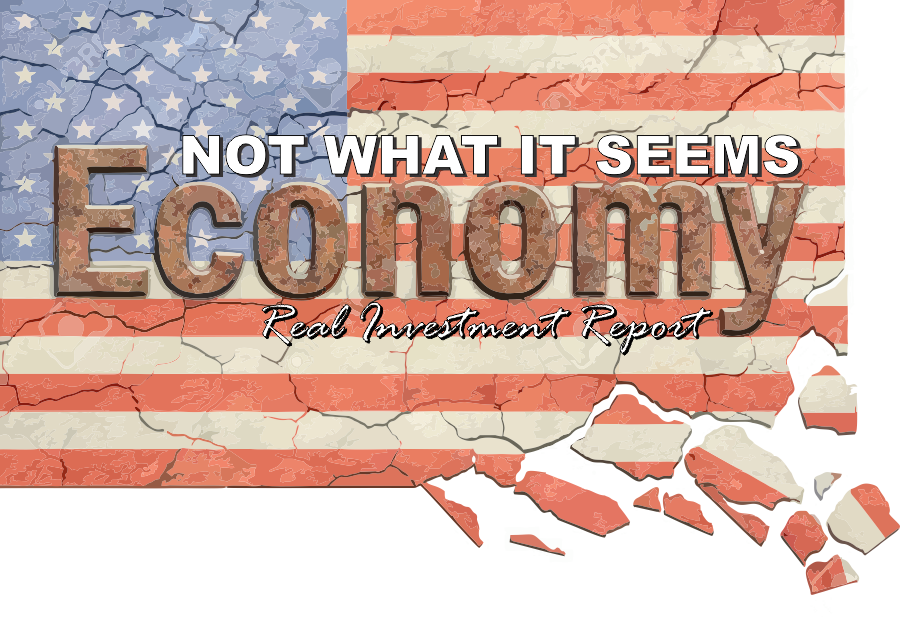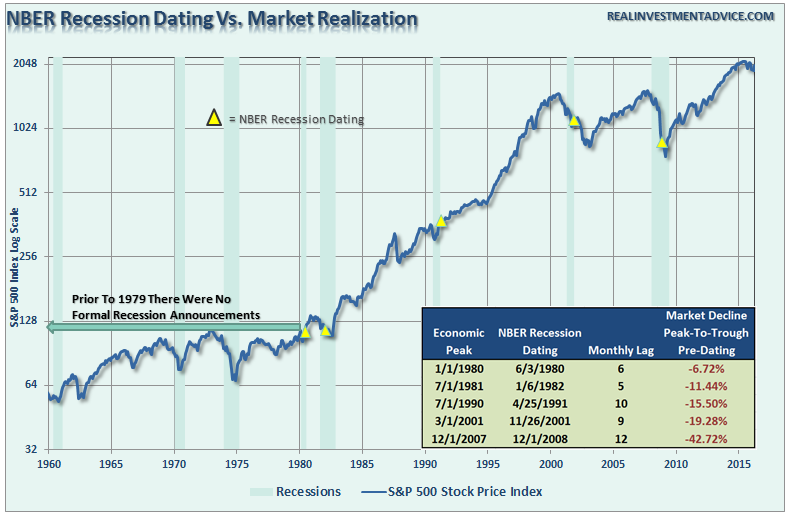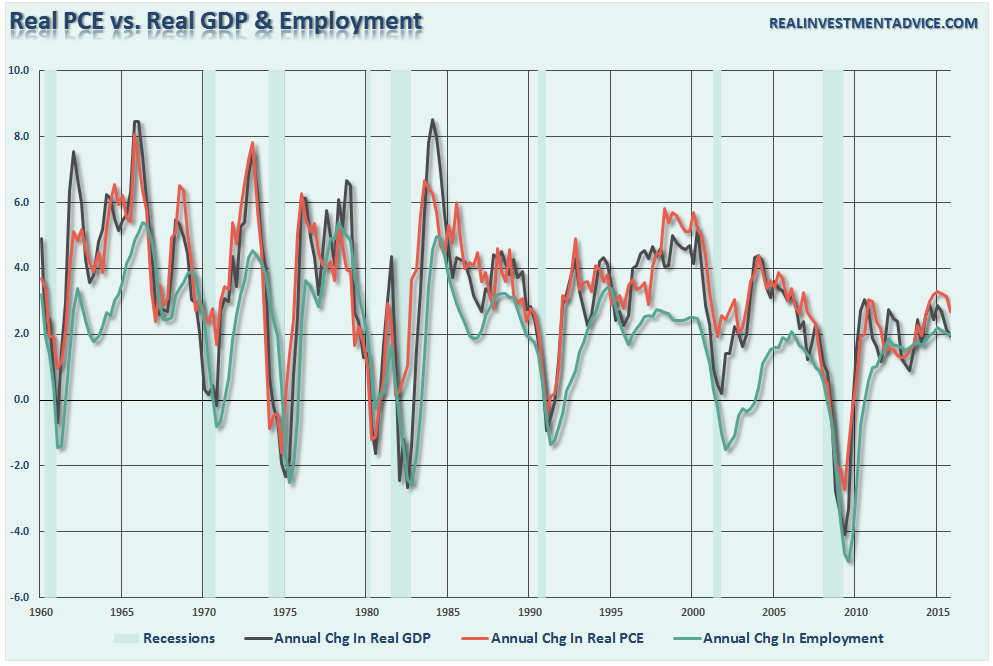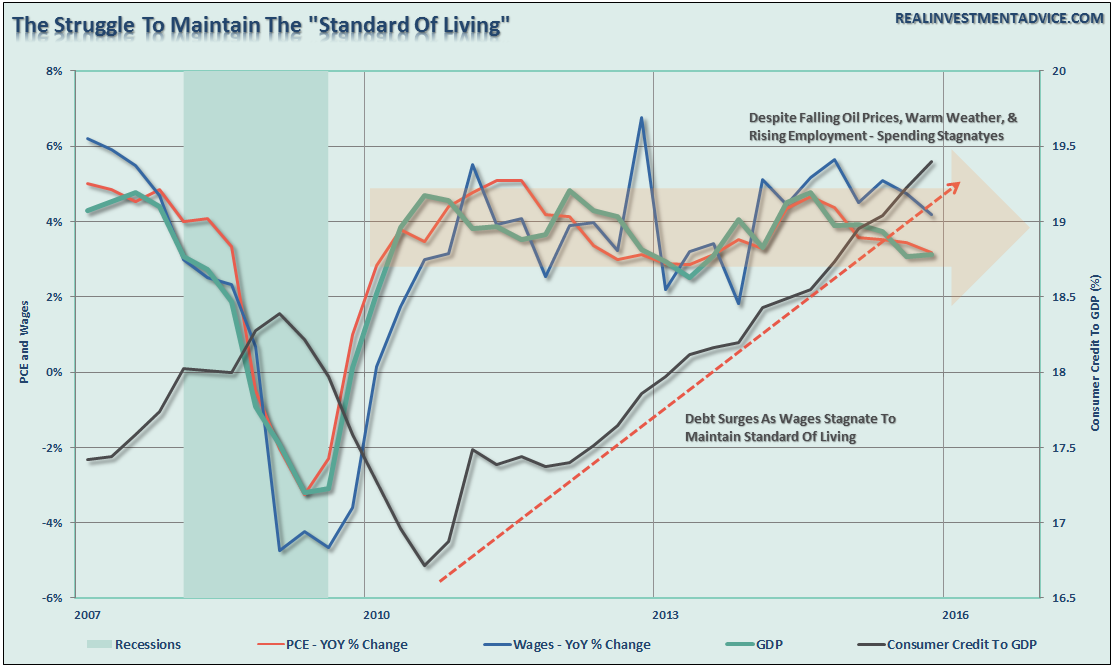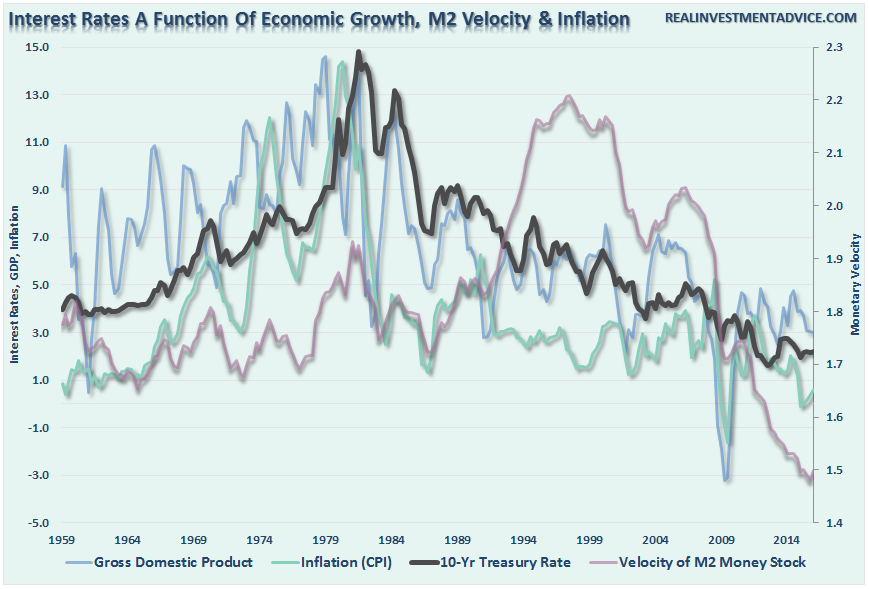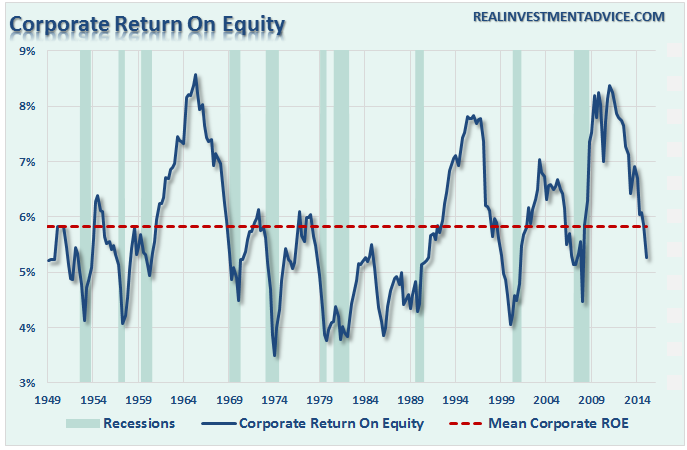Over the past several years, I have repeatedly discussed the ongoing detachment between the economic reports versus what was happening in the actual underlying economy. Last year, I wrote:
“Currently, there is little evidence that is supportive of higher overnight lending rates. In fact, the current environment continues to support the idea of a “liquidity trap” that I began discussing in 2013. To wit:
‘…a situation described in Keynesian economics in which injections of cash into the private banking system by a central bank fail to lower interest rates and hence fail to stimulate economic growth. A liquidity trap is caused when people hoard cash because they expect an adverse event such as deflation, insufficient aggregate demand, or war. Signature characteristics of a liquidity trap are short-term interest rates that are near zero and fluctuations in the monetary base that fail to translate into fluctuations in general price levels.’”
The importance of a liquidity trap can not be dismissed as the feedback loop of monetary interventions negatively impact growth by misallocated capital to non-productive uses.
Despite mainstream economists hopes that somehow “this time will be different,” the ongoing massaging of economic data through seasonal adjustments to obtain better headlines did not translate into actual prosperity. Of course, “reality” is a cruel mistress and despite ongoing hopes and overstatements, “fantasy” eventually gives way.
The chart below shows the S&P 500 index with recessions and when the National Bureau of Economic Research dated the start of the recession.
There are three lessons that should be learned from this:
- The economic “number” reported today will not be the same when it is revised in the future.
- The trend and deviation of the data are far more important than the number itself.
- “Record” highs and lows are records for a reason as they denote historical turning points in the data.
Economic Growth Not What It Seems
The last two-quarters of economic growth have been less than exciting, to say the least. However, these rather dismal quarters of growth come at a time when oil prices and gasoline prices have plummeted AND amidst one of the warmest winters in 65-plus years.
Why is that important? Because falling oil and gas prices and warm weather are effective “tax credits” to consumers as they spend less on gasoline, heating oil and electricity. Combined, these “savings” account for more than $200 billion in additional spending power for the consumer. So, personal consumption expenditures should be rising, right?
What’s going on here? The chart below shows the relationship between real, inflation-adjusted, PCE, GDP, Wages and Employment. The correlation is no accident.
Economic cycles are only sustainable for as long as excesses are being built. The natural law of reversions, while they can be suspended by artificial interventions, can not be repealed.
More importantly, while there is currently “no sign of recession,” what is going on with the main driver of economic growth – the consumer?
The chart below shows the real problem. Since the financial crisis, the average American has not seen much of a recovery. Wages have remained stagnant, real employment has been subdued and the actual cost of living (when accounting for insurance, college, and taxes) has risen rather sharply. The net effect has been a struggle to maintain the current standard of living which can be seen by the surge in credit as a percentage of the economy.
To put this into perspective, we can look back throughout history and see that substantial increases in consumer debt to GDP have occurred coincident with recessionary drags in the economy.
“No sign of recession? Are you sure about that?”
“Despite rumors to the contrary, since 2013, the bond bull market remains alive and “kicking.” This is no surprise as I have written many times in the past, as interest rates, and ultimately bond prices, are a direct reflection of real economic strength and inflationary pressures.”
“Furthermore, the recent decline in rates likely suggests a much weaker economic environment than is currently expected. The last time that rates were this low, and potentially heading lower, was during the economic slowdown in 2012 which bordered on a recession.
In 2012, the Federal Reserve was in extreme accommodation mode, profits were growing and multiples were expanding. That is not the case today.
The takeaway of all this is the risk to equities may be higher than currently expected. If rates, economic data trends, and valuation reversions are sending the correct message, the forthcoming negative revisions to the underlying data will derail the current bullish thesis of a profits recovery in the making.”
I Told You So
So, why all the rehash of commentary from the past three years. Simple. Because, of the following:
“The Department’s Bureau of Economic Statistics (BEA) regularly makes small revisions to its published statistics as more information becomes available over time. But in a massively large adjustment, the BEA just revised downward — by $346 billion — the real (after-inflation) GDP for 50 states and the District of Columbia, covering the 11-year period from 2005 through the end of 2015.
According to BEA’s newest data, real GDP was overstated by about $125 billion from 2007 through 2008, during the period leading into the start of the Great Recession. But the overstatement shrank to about $70 billion in 2009.
During 2012 and 2013, when the U.S. economy had what some have referred to as a micro-recession, the overstatement of real GDP growth ballooned to about $275 billion. Despite over $100 billion in revisions to real GDP growth in 2014 and 2015, the overstatement continued to grow to $324 billion, or 2 percent of GDP.”
This announcement of negative adjustment to GDP is obviously no surprise to regular readers of this newsletter. Since the beginning of this year, I have been hammering on the problem of seasonal adjustments.
“Importantly, the extremely warm winter weather is currently wrecking havoc with the seasonal adjustments being applied to the economic data. This makes every report from employment, retail sales, and manufacturing appear more robust than they would be otherwise. However, as the seasonal trends turn more normal we are likely going to see fairly negative adjustments in future revisions. This is a problem that the mainstream analysis continues to overlook currently, but will be used as an excuse when it reverses.”
Here is my point. While my call of a forthcoming “recession” may seem far-fetched based on today’s economic data points, it should be remembered that no one was calling for a recession in early 2000 or 2007 either.
Furthermore, given the weakness in corporate profits and declining return on equity, it is extremely likely the current economic estimates are substantially weaker as well. This suggests that by this time next year, we will once again find out the economy was as weak as corporate profits were already suggesting. Unfortunately, by the time the data is adjusted, and the eventual recession is revealed, it won’t matter as the damage will likely have already been done.
While being optimistic about the economy and the markets currently is far more entertaining than doom and gloom, it is the honest assessment of the data and the underlying trends that is useful in protecting one’s wealth longer term.
Is there a recession currently? No.
Will there be a recession in the not so distant future? Absolutely.
While calls for a “massive recession” may very well turn out not to be true, even a mild recession could have a substantial impact on personal wealth given the current deviation in prices from long-terms norms.
Getting to say “I told you so” isn’t the point of this missive. What is important is understanding that “bullish exuberance” will likely meet its same fatal ending as it always has. Understanding that “risk” is simply a function of how much you will “lose” when you are eventually wrong is the key to surviving the next major market downturn.
“In a bear market, the man who wins is the man who loses the least.” – Dick Russell
Lance Roberts is a Chief Portfolio Strategist/Economist for Clarity Financial. He is also the host of “The Lance Roberts Show” and Chief Editor of the “Real Investment Advice” website and author of “Real Investment Daily” blog and “Real Investment Report“. Follow Lance on Facebook, Twitter and Linked-In


